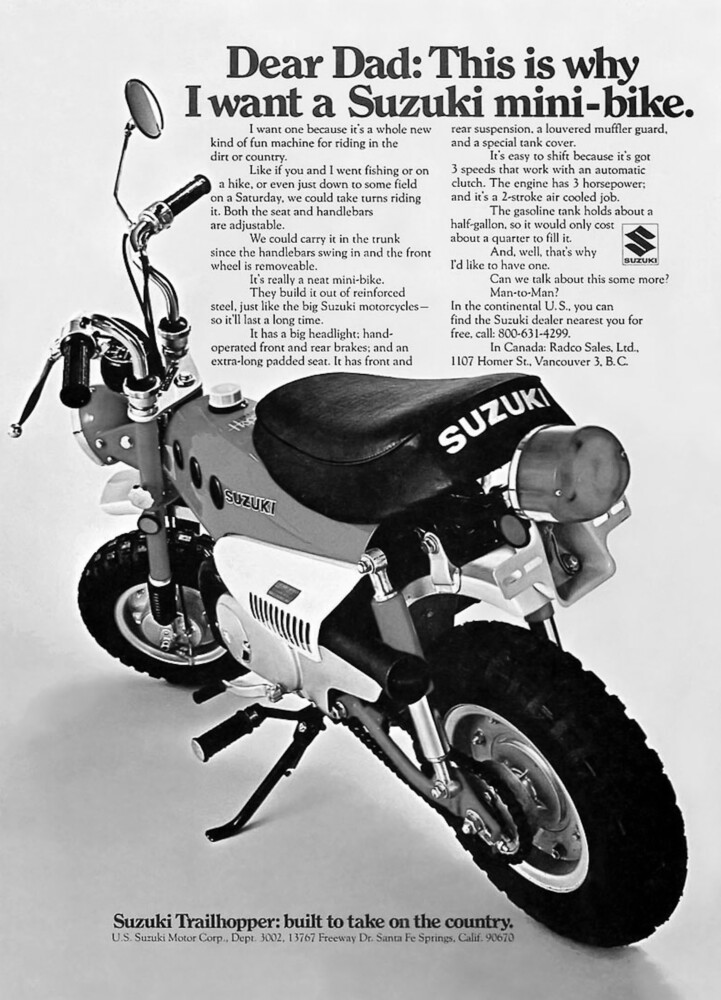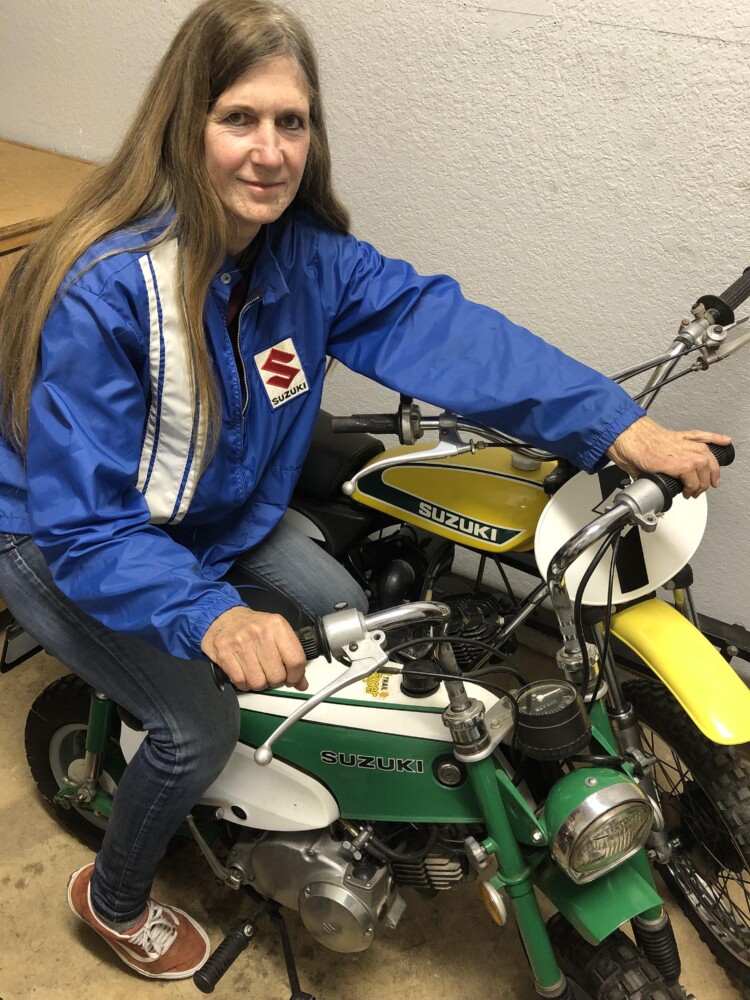| April 9, 2023
Cycle News Archives
COLUMN
Suzuki’s Tiny Two-Stroke
By Kent Taylor
In his 1932 novel Brave New World, writer Aldous Huxley imagines a future society that is built partly upon the idea that conformity is necessary for a peaceful existence. While Huxley’s dystopian tale does not specifically mention motorcycles, one wonders if he might have envisioned a day in which all two-wheeled machines perform, sound and even look alike—so much so that even the most discerning motorcyclist must look closely for a brand name on a decal in order to distinguish one cycle from another? In Huxley’s words, a “swarming indistinguishable sameness.”
Motorcycling was once a world comprised of many variations of two-wheeled machines. The battle for street supremacy was being waged by motorcycles powered by both two-cylinder four-strokes and four-cylinder two-strokes—with some manufacturers offering three-cylinder machines in both configurations! Meanwhile, out in the trenches, there were various models of more two-strokes and four-strokes, singles and twins, each claiming off road superiority over their opponents.
This world of many motorcycles stretched out to include even the little people. The mighty Honda Z50 four-stroke Mini-Trail may have sat on the throne, but Suzuki had designs on the crown. Their weapon of choice to capture a slice of the burgeoning minicycle market was the MT50 Trailhopper.
 The two-stroke Suzuki Trailhopper debuted in 1971.
The two-stroke Suzuki Trailhopper debuted in 1971.
In 1971, just as Honda was known as a four-strokes-only company, Suzuki was equally as committed to the two-stroke design. The Trailhopper borrowed its engine from Suzuki’s step-through 50, and it featured an automatic clutch for easy shifting through its three-speed transmission. With Suzuki’s CCI (crankcase cylinder injection), a separate oil pump squirted two-stroke lubricant at key engine internals, thus eliminating the need for mixing gasoline and oil.
Then and now, the little Suzuki is a futuristic-looking machine. Stylish body work hiding the fuel tank makes the Trailhopper far too snazzy for Huxley’s World State city, but the MT certainly looks like a bike that George Jetson might’ve been cajoled into buying for his boy, Elroy. It’s $329 MSRP would have made it affordable for George, even with his two-hour work week at Spacely Space Sprockets. On his bright orange (or blue or green) Suzuki MT50 Trailhopper, Elroy would’ve been the coolest kid in all of Orbit City!
For a 10-year-old in 1972, the only thing better than getting a Suzuki MT50 Trailhopper would be getting a free Suzuki Trailhopper, which is how a young Kimberley Wright came into possession of her very own bike.
“It was a drawing contest open to family members of employees of the U.S. Suzuki Corporation” Wright recalls. The objective was to “design a Christmas card for Suzuki. Some of the runner-up awards included a Team Suzuki jacket and some magazine subscriptions, but the grand prize was a 1973 Trailhopper.”
Kimberley’s dad already sported his own Team Suzuki jacket, and he was likely even featured in some of those magazines; her pop was none other than 1960s road racer Merv Wright. Wright had piloted a Norton Manx at the Isle of Man and later raced an almost legendary bike a heavily modified Parilla 175 known as “The Gadget.” When his racing days were over, he joined Team Suzuki, first as a mechanic for fellow road racer Ron Grant before eventually being promoted to team manager.
“I remember there were many different motorcycles [Norton, Triumphs, etc.] with the big fairings parked in our house,” Wright recalls. “The neighborhood kids and I would get to sit on them. In mid-70s, we would tag along to the races with Barry Sheene and Roger DeCoster. I have been riding and tinkering on Suzukis ever since!”
Kimberley had submitted numerous designs for the contest, but it was her initial sketch (which actually featured her rendition of an MT50) that was selected.
 Kimberly Wright and her dear Suzuki MT50 Trailhopper.
Kimberly Wright and her dear Suzuki MT50 Trailhopper.
“My dad, with his English accent, had a very dry sense of humor, so when he told me that I’d won I thought he was kidding! We laughed about that one, because I had spent hours drawing and designing so many different entries and they wound up choosing my first submission!”
Even though she was already the partial owner of a Trailhopper (one she was required to share with her brother), she now had her own motorcycle, which she would ride with the boys at Saddleback Park in Southern California. And if the lads couldn’t comprehend a girl on a dirt bike, they received a quick education! While the Suzuki couldn’t touch the Honda Mini Trail in sales numbers, once the bikes were off the showroom floor, it was a different story. “My brother and I could blow right past the boys on their Z-50s,” she remembers. “The two-stroke was much quicker!”
Even if you weren’t lucky enough to win a Trailhopper, the reasonable retail price made it easier to convince Mom and Dad that the little 50 would be the perfect gift, be it December or March.
“It was March 27, 1971, when my Dad surprised me with a Trailhopper,” Peter Zack, of Deep River, Connecticut, says today. “I even still have the original sales receipt for $324.45 from Valley Motorcycle Center!”
Both the seat and handlebars on the Trailhopper were somewhat adjustable, so the bike could be shared by family members of all sizes. “My two sons also got to enjoy it when they were growing up,” Zack adds. “I still own it and love taking it out for a ride once in a while.”
The MT50 didn’t have a long run in the Suzuki lineup; appearing first in 1971, the Trailhopper was absent from the 1974 model list. But as with many other under-appreciated motorcycles of the past, the Trailhopper has never really died. Kids who were once proud owners of them became adults who can’t live without them, leading to nationwide searches for bikes to replace the one that somehow got away. Owners claim most parts can be easily found, with the exception of the oft-missing right-side oil tank cover. “It was held on by a couple of knobbies and one dial bolt,” Kimberley Wright says. “It never stood a chance being thrashed about as a two-stroke ripper!”
The sidecovers have become like the Holy Grail for parts seekers. Trailhopper owner Joe Carino of Williamstown, New Jersey, finally found a NOS cover for his bike. “Let’s just say I paid more for my oil tank cover than I did for the bike,” he says, “and I got a smokin’ deal on that cover!”
Wright’s own Suzuki sadly went away years ago. “The Trailhoppers had been sitting in the garage for few years,” she says, “and my Dad offered us now ‘teens’ [brother and I] $250 each for the bikes, as his buddy wanted them. It seems dumb now, but at that age in the late ‘70s, $250 was a lot of money.”
Nearly 40 years later, she found another Trailhopper and then added one more as a parts bike. Between the two, she has built a replica of the Trailhopper she won as a 10-year-old. This time around, she isn’t letting go of the little bike.
“It won’t,” Wright says firmly, “be sold in my lifetime!”